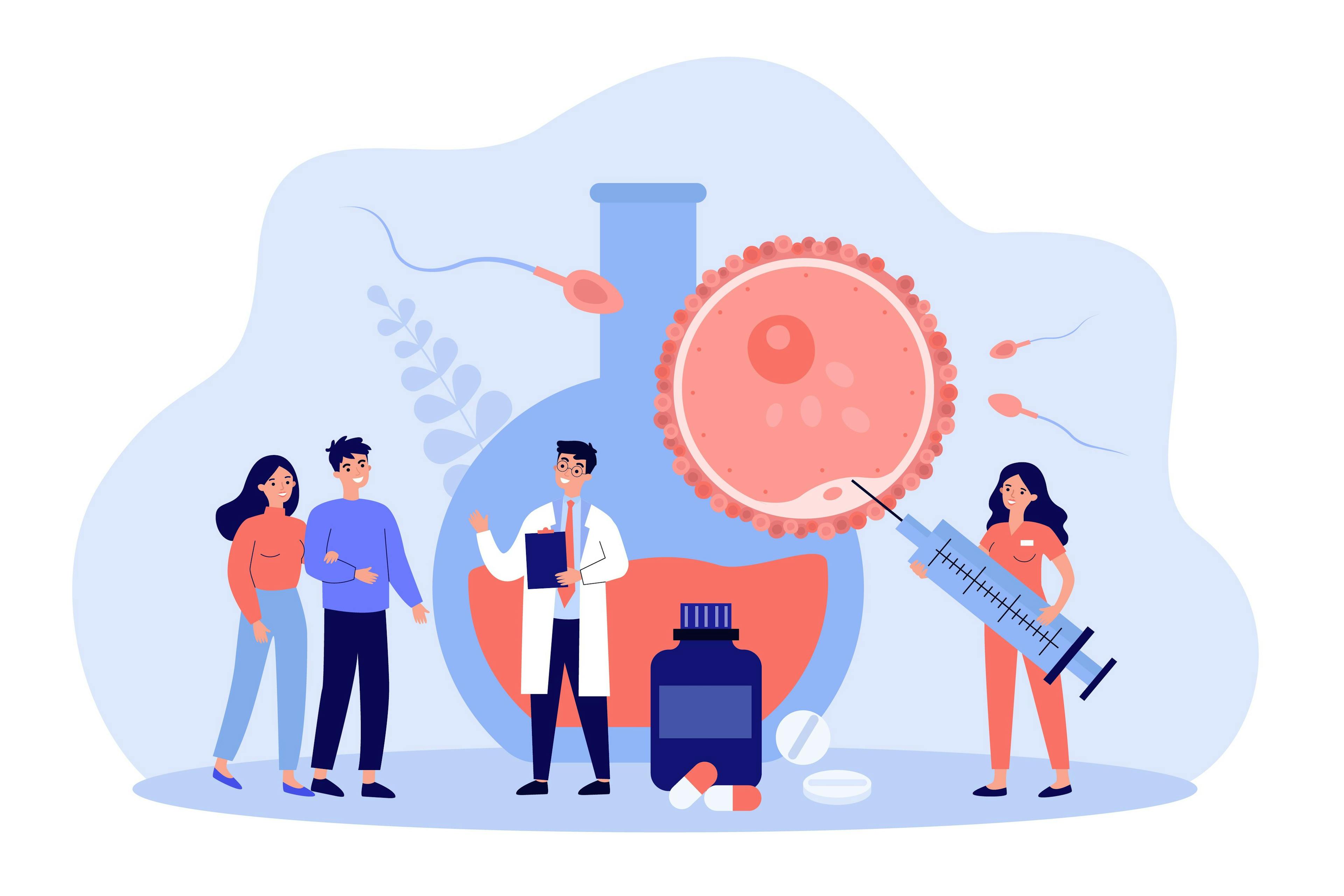Call us today on +44 7897 035438
How long does IVF take after the first appointment?
If you're considering in-vitro fertilisation (IVF), you may have wondered how long the process takes from start to finish.
For most people, one cycle of IVF takes around six weeks, but the timeline of IVF can vary based on your health, the treatment plan you’re on, and the fertility clinic.
Navigating fertility treatments can be overwhelming, so we give you the lowdown on how long IVF usually takes and what kind of tests or procedures you can expect at each stage.

Understanding the timeline of IVF
The IVF process involves different treatment stages, called a "cycle". These stages include:
suppressing natural hormone production
hormone treatment to increase egg supply
egg collection
mixing the eggs and sperm
and finally, embryo transfer.
The length of the treatment varies depending on your recommended treatment plan, but for most people, one cycle of IVF typically lasts between four and six weeks.
It's important to remember that every patient is unique, so the length of treatment may vary depending on the treatment protocol, and from clinic to clinic.
First appointment: Initial consultation
At Apricity, all patients are offered an initial call with either a fertility advisor or nurse, who will review your medical history and previous test results. They'll take the time to discuss any past fertility treatments you've undergone, and together, you'll determine if IVF is the right option for you.
If this first consultation is with a nurse, you can discuss potential treatment options. However, the doctor does the main discussion and review of results during their full consultation.
Don’t be afraid to ask for more information if you have any questions or concerns about the IVF treatment process, costs and payment plans, waiting times, or the clinic's success rates. That’s what this first appointment is for!
In some cases, your doctor may recommend additional blood tests or investigations. They may suggest a pelvic ultrasound scan to assess your ovarian function or examine your uterus, fallopian tubes, ovaries, or cervix.
For male partners, they might recommend a semen analysis to assess the health of their sperm. Don't worry; your advisor explain everything in detail during your consultation.
Pre-treatment tests and evaluations
Before your IVF cycle, you (and your partner, in the case of couples) will have tests to check your health and fertility status. These tests include:
anti-müllerian hormone (AMH) blood test to check your ovarian reserve and predict how your ovaries will respond to IVF treatment. Some clinics, including Apricity, offer at-home AMH tests.
Hormone screening & thyroid?
a vaginal ultrasound to check the uterus and ovaries.
HIV, hepatitis B, and hepatitis C screening
sperm analysis.
Your doctor may suggest taking the oral contraceptive pill or progestogen tablets for a few weeks before IVF. This helps them figure out when you should start taking fertility drugs by tracking your menstrual cycle.
If you're considering using donor eggs, all IVF clinics in the UK are required to screen donor eggs and sperm.
Ovarian stimulation and monitoring
To kick things off, you’ll be offered a course of fertility medication to produce more eggs. The more eggs are available to collect, the more can be fertilised to create embryos. This gives the clinic a wider selection of embryos for your treatment. Ovarian stimulation is proven more effective than relying on just one egg from your natural cycle without any hormone assistance, known as “natural-cycle IVF”.
Depending on your treatment type, you may be recommended a “long protocol, " including suppressing your body’s natural hormone production. You’ll be prescribed gonadotropin-releasing hormone (GnRH) antagonists in the form of a daily injection or nasal spray to temporarily "switch off" your ovaries. This is known as ovulation down-regulation, and it's used to make the ovaries more receptive to the drugs used to stimulate them later.
Then, you will be prescribed follicle-stimulating hormone (FSH), which encourages your ovaries to produce more eggs. The medication comes as a daily self-administered injection that you’ll take for roughly ten days, but the treatment length can vary from person to person. It might take longer if your body doesn’t respond to the fertility medications or there aren’t enough developed follicles.
After taking FSM, your ovaries will be monitored with ultrasound scans and blood tests in the clinic to ensure they're doing well and to check for ovarian hyperstimulation syndrome. This condition can happen if your body reacts too strongly to the fertility drugs. These tests are usually fone every two to three days, but it can depend on your medical history and how you’re responding to medication.
Egg retrieval
During the egg collection, you’ll be sedated or given a general anaesthetic to make you comfortable. To collect the eggs, the doctor will insert a needle guided by ultrasound through your vagina and into each ovary. This process usually takes about half an hour, and you may experience cramps or light vaginal bleeding afterwards.
While the eggs are being collected, the male partner will be asked to provide a sperm sample. If you’re using donor sperm, it will be taken from the freezer and mixed with your eggs.
Fertilisation and embryo development
On the day the eggs and sperm are collected, they'll be mixed in a lab. The aim is for the eggs and sperm to fertilise to create an embryo — literally "in vitro fertilisation"!
In cases where male infertility is part of the diagnosis, each egg may need to be injected individually with a single sperm, a process called intracytoplasmic sperm injection (ICSI).
The embryos will grow in the lab for up to six days. The best embryo will then be transferred back into your womb.
To help you prepare for the embryo transfer, you'll be given hormones (in the form of an injection or vaginal pessary or gel) to prepare the lining of the uterus for the embryo transfer.
Embryo transfer
Once ready, the embryos will be transferred into your womb using a thin tube called a catheter passed into your vagina. It's a simple procedure similar to a cervical screening test, so you won't need anaesthesia.
Before the procedure, your doctor will discuss how many embryos to transfer. The decision to transfer one or two embryos depends on your age, the quality of the embryos, and whether you've had unsuccessful IVF cycles in the past. Younger women usually have better-quality embryos, which can improve the chances of pregnancy. If you're using donor eggs, your clinic will use the donor's age rather than your age to judge the embryo quality.
Transferring multiple embryos increases the risk of a multiple pregnancy, which can increase your risk of pregnancy complications Transferring more than two embryos at one time isn't recommended.
After the embryo transfer, you'll be prescribed progesterone for up to eight weeks to help the embryo attach inside the womb.
Two weeks after the embryo transfer, you can take a pregnancy test! You can take an at-home test, or your clinic might ask you to come for a blood test to see if you're pregnant. As tempted as you might be, try not to take a pregnancy test earlier than recommended because even the most sophisticated pregnancy tests can't reliably detect a pregnancy earlier than two weeks. This phase is referred to as the “two-week wait”.
Embryo cryopreservation (optional)
Many people going through IVF opt to freeze any leftover embryos for future use, known as embryo cryopreservation. This gives you options if you need to try IVF again because treatment was unsuccessful or because you want to have another baby.
Thawing and using these embryos in a new treatment cycle is known as frozen embryo transfer (FET). It means you won't have to go through all the initial steps of IVF again.
Before embryos can be frozen, both you and your partner or donor must give your informed permission. It's important that you're fully informed about the process and sign all relevant consent forms. These forms will cover things like how long you want to store the embryos, what should happen to them if you can't make decisions, and whether you're okay with them being used for someone else's treatment or research. You can also add any special conditions you want to the consent forms.
You can learn more about your rights when freezing embryos on the Human Fertilisation and Embryology Authority's (HFEA) website.
Conclusion
Starting IVF treatment can be daunting, but understanding the process — and how long it will take — can make it less overwhelming. The length of IVF depends on your specific treatment plan, but for most individuals and couples struggling with infertility, one cycle of IVF typically lasts between four and six weeks.
It's worth noting that every person's IVF experience is unique, and the outcome can be unpredictable. Age, medical conditions, and lifestyle factors can significantly affect the process. So, while some women conceive right away, others may need to undergo multiple cycles. Your doctor will walk you through the ins and outs of IVF success rates but know that just because it didn't work the first time doesn't mean all hope is lost.
References
(n.d.). IVF. NHS. https://www.nhs.uk/conditions/ivf/getting-started/
(n.d.). Before starting IVF. National Institute for Health and Care Excellence. https://www.nice.org.uk/guidance/cg156/ifp/chapter/Before-starting-IVF
(n.d.). IVF. NHS. https://www.nhs.uk/conditions/ivf/getting-started/
(n.d.). What happens in IVF? National Institute for Health and Care Excellence. https://www.nice.org.uk/guidance/cg156/ifp/chapter/Before-starting-IVF

Written by Olivia Cassano
WriterKeep reading
Why Apricity
Preserve Fertility
Fertility Treatments
Egg Donation
Ⓒ Apricity Fertility UK Limited. All rights reserved


